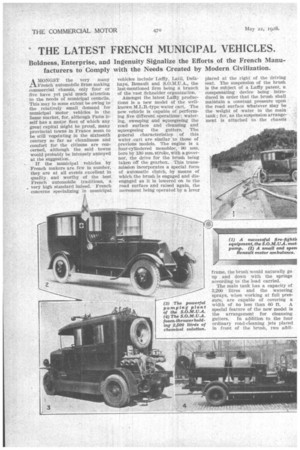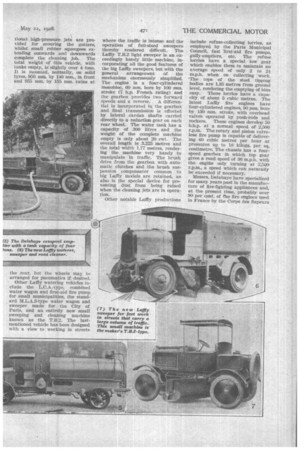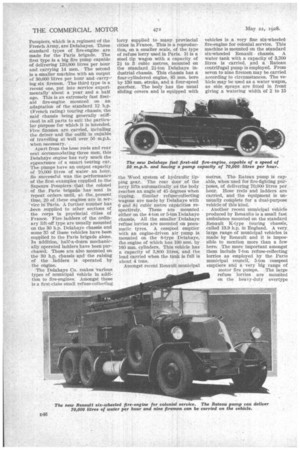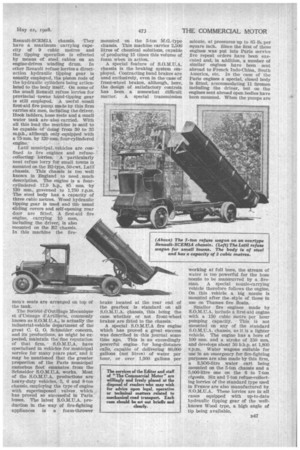THE LATEST FRENCH MUNICIPAL VEHICLES.
Page 118

Page 119

Page 120

Page 121

If you've noticed an error in this article please click here to report it so we can fix it.
Boldness, Enterprise, and Ingenuity Signalize the Efforts of the French Manufacturers to Comply with the Needs Created by Modern Civilization.
A MONGST the, very many ..ti.French automobile firms making commercial chassis, only four or five have yet paid much attention to the needs of municipal councils. Thisinay to some extent be owing to the relatively small demand for municipal motor vehicles in the home market, for, although Paris itself has a motor fleet of which any great capital might be proud, many provincial towns in France seem to be still vegetating in the sixteenth century so far as cleanliness and comfort for the citizens are concerned, although the said towns would probably be intensely annoyed at the suggestion.
If the municipal vehicles by French makers are few in number, they are at all events excellent in quality and worthy of the _best French automobile traditions, a . verY high standard indeed. French concerns specializing in municipal vehicles include Lathy, TAW, Delahaye, Renault and S.O.M.U.A., the last-mentioned firm being a branch of the vast Schneider organization.'
Amongst the latest Lally productions is a new model of the well, known M.L.B.-type water cart. The new vehicle is capable of performing .five different operations: watering, sweeping and squeegeeing the road surface and cleansing and squeegeeing the gutters. The general characteristics of this water cart are similar to those of previous models. The engine is• a four-cylindered monobloc, 90 mm. bore by 130 mm. stroke, with a governor, the drive for the brush being • taken off the gearbox. This transmission incorporates a special form of automatic clutch, by means of which the brush is engaged and disengaged as it is lowered on to the road surface and raised again, the movement being operated by a lever placed at the right of the driving 'seat. The suspension of the brush is the subject of a Lathy patent, a compensating device being introduced in order that the brush shall maintain a constant pressure upon the road surface whatever May be the weight of water in the main tank ; for, as the suspension arrangement is attached to the chassis
frame, the brush would naturally go up and down with the springs according to the load carried.
The main tank has a capacity of 3,200 litres and the watering sprays, when working at full pressure, are capable of covering a width of no less than 60 ft. A • special feature of the new model is the arrangement for cleansing gutters. In addition to the four ordinary road-cleaning jets placed in front of the brush, two adcli tionai high-pressure jets are provided for scouring the gutters, whilst small rubber squeegees extending outwards and downwards complete the cleaning job. The total weight of this vehicle, with tanks empty, is slightly over 4 tons. It is mounted, normally, on solid tyres, 950 mm. by 140 mm., in front and 055 mm. by 155 mm. twins at the rear, but the wheels may be arranged for pneumatics if desired.
Other Laffly watering vehicles include the L.C.A.-type, combined water wagon and first-aid fire pump for small municipalities, the standard M.L.A.3-type water wagon and sweeper made for the City of Paris, and an entirely new small sweeping and cleaning machine known as the T.B.2. The lastmentioned vehicle has been designed with a view to working in streets
where the traffic is intense and the operation of full-sized sweepers thereby rendered difficult. The Lafily T.B2 light sweeper is an exceedingly handy little machine, incorporating all the good features of the big Lally sweepers, but with the general arrangement of the mechanism enormously simplified. The engine is a fonr-cylinderecl monobloc, 60 mm. bore by 100 ram. stroke (7 h.p. French rating) and the gearbox provides two forward speeds and a reverse. A. differential is incorporated in the gearbox and final transmission is effected by lateral cardan shafts carried directly to a reduction gear on each rear wheel. The water tank has a capacity of 300 litres and the weight of the complete machine empty is only about 20 cwt. The overall length is 3.225 metres and the total width 1.77 metres, rendering the machine very handy to manipulate in traffic. The brush drive from the gearbox with automatic clutches and the brush suspension compensator common to big Lany models are retained, as also is the special device for preventing dust from being raised when the cleaning jets are in operation.
Other notable Lally productions
include refuse-collecting lorries, as employed by the Paris Municipal Council, fast first-aid fire pumps, gully-enaptiers, etc. The refuse lorries have a special low gear which enables them to maintain an average speed of only 2 to 21) m.p.h. when on collecting work. The tops of the steel tipping bodies are 1.35 metres from ground level, rendering the emptying of bins easy. These lorries have a capacity of about 5 cubic metres. The latest Laffly tire engines have four-cylindered engines, 90 ram. bore by 130 mm. stroke, with overhead valves operated by push-rods and rockers. These engines develop. 50 b.h.p. at a normal speed of 2,500 r.p.m. The rotary and piston valveless fire pump is capable of delivering 60 cubic metres per hour at pressures up to 10 kilogs. per sq. centimetre. The chassis has a fourspeed gearbox in which top gear gives a road speed of 36 m.p.h. with the engine only turning at 2,500 r.p.m., a speed which can naturally be exceeded if necessary.
Messrs. Delahaye have specialized for many years past in the manufacture of fire-fighting appliances and, at the present time, probably over 90 per cant. of the fire engines used in France by the Corps des Sapeurs
Pompiers, which is a regiment of the French Army, are De.lahayes. Three standard types of fire-engine are made for the Paris brigade. The first type is a big fire pump capable of delivering 120,000 litres per hour and carrying 14 men. The second is a smaller machine with an output of 30,000 litres per hour and carrylug six firemen. The third type is a recent one, put into service experimentally about a year and a half ago. This is an extremely fast fir-staid fire-engine mounted on an adaptation of the standard 12 h.p. (French rating) touring chassis, the said chassis being generally stiffened in all parts to suit the particular purpose for which it is intended. Five firemen are carried, including the driven and the outfit is capable of travelling at well over 50 m.p.h. when necessary.
Apart from the hose reels and rear seat accommodating three men; this Delahaye engine has very much the appearance of a smart touring car. The pumps have an output capacity of 70,000 litres of water an hour. So successful was the performance of the first examples supplied to the Sapeurs Pompiers: that the colonel of the Paris brigade has sent in repeat orders until, at, the present time, 20 of these engines are in ser, vice in Paris. A further number has .been supplied to other sections of the corps in provincial cities of France. Fire ladders of the ordinary lift-off type are usually mounted on the 30 h.p. Delahaye chassis and some 35 of these vehicles have been supplied to the Paris brigade alone. In addition, half-a-dozen mechanically operated ladders have been purchased. These are also mounted on the 30 h.p. chassis and the raising of the ladders is operated by the engine.
The Delahaye Co. makes various types of municipal vehicle in addition to fire-engines. Amongst these IS a first-class small refuse-collectieg lorry supplied to many provincial cities in France. This is a reproduction, on a smaller scale, of the type of refuse lorry used in Paris. It is a steel tip wagon with a capacity of 21 to 3 cubic metres, mounted on the standard 21-ton Delahaye industrial chassis. This chassis has a four-cylindered engine, 85 mm. bore by 130 mm. stroke, and a four-speed gearbox. The body has the usual sliding covers and is equipped with
the Wood system of hydraulic tipping gear. The rear door ,of the lorry lifts automatically as the body reaches an angle of 45 degrees when tipping. Similar refuse-cellecting wagons are made by Delahaye with 6 and 81 cubic metre capacities respectively. These are mounted either on the 4-ton or 5-ton Delahaye chassis. All the smaller Delahaye reffise lorries are mounted on pneumatic tyres. A cesspool emptier with an engine-driven air pump is mounted on the 8-type Delabaye, the engine of which has 100 mm. by 160 mm. cylinders. This vehicle has a capacity of 3,800 litres, and the load carried when the tank is full is about 4 tons.
Amongst recent Renault municipal
vehicles is a very fine six-wheeled fire-engine for colonial service. This machine is mounted on the standard six-wheeled Renault chassis. A water tank with a capacity of 3,200 litres is carried, and a Rateau centrifugal pump is employed. From seven to nine firemen may be carried according to circumstances. The vehicle may be used as a water wagon, as side sprays are fitted in front giving a watering width of 2 to 15 metres. The Bateau pump is capable, when used for fire-fighting purposes, of delivering 70,000 litres per. hour. Hose reels and ladders are carried, and the equipment is unusually complete for a dual-purpose vehicle of this kind.
Another recent municipal vehicle produced by Renaults is a small fast ambulance mounted on the standard Renault K-type touring chassis, called 18.9 h.p. in England. A very large range of municipal vehicles is made by Renault and it is impossible to mention more than a few hems. The more important amongst them include 7-ton refuse-collecting lorries as employed by the Paris municipal council, 5-ton cesspool eraptiers and a very big range of motor fire pumps. The large refuse lorries are mounted on the heavy-duty overtype Renault-SCEMIA chassis. They have a maximum carrying capacity of 0 cubic metres and the tipping operation is effected by means of steel cables on an engine-driven winding drum. In other Renault refuse lorries a directaction hydraulic tipping gear is usually employed, the piston rods of the hydraulic cylinders being articulated to the body itself. On some of the small Renault refuse lorries for provincial ...towns hand-tipping gear is still employed. A. useful small first-aid fire pump made by this firm carries six men, including the driver. Hook ladders, hose reels and a small water tank are also carried. With all this load the machine is said to be capable of doing from 30 to 35 m.p.h., although only .equipped with a 75 tam. by 120 mm. four-cylinclered engine..
Latil municipal. vehicles are confined to fire engines and refusecollecting. lorries. A particularly neat refuse lorry for small towns is mounted on the 132-type, 50-cwt. Lathl chassis. This chassis is too well known in England to need much description. The engine is a fourcylindered 17.9 h.p., 85 mm. by 130 mm., governed to 1,750 r.p.m. The steel body has a capacity of three cubic metres. Wood hydraulic tipping gear is used and We usual sliding covers and self-opening rear door are fitted. A first-aid tire engine, carrying 10 men, including the driver, is also mounted on the B2 chassis. In this machine the fire
men's seats are arranged on top of the tank.
The Societe d'Outifiage Mecanique et d'Usinage d'Artillerie, commonly known as S.O.M.U.A., is actually the industrial-vehicle department of the great C. G. 0. Schneider concern, and its productions, as might be expected, maintain the fine reputation of that firm. S.O.M.U.A. have specialized in vehicles for municipal service for many years past, and it may be mentioned that the greater proportion of the Paris municipal motorbus fleet emanates from the Schneider S.O.M.U.A. works. Most of the S.O.M.U.A. productions are heavy-duty vehicles, 5, 6 and 8-ton chassis, employing the type of engine with superimposed valves which has proved so successful in Paris buses. The latest S.O.M.U.A. production in the way of fire-fighting appliances is a foam-thrower mounted on the 5-ton Ma-type chassis. This machine carries 2,500 litres of chemical solutions, capable of producing 15 times this volume of foam when in action.
A special feature of S.O.M.U.A. chassis is the braking system employed. Contracting band brakes are used exclusively, even in the case of front-wheel brakes, although, here, the design of satisfactory controls has been a somewhat difficult matter. A special transmission brake located at the rear end of the gearbox is standard on all S.O.M.U.A.• chassis, this being the case whether or not front-wheel brakes are fitted to the chassis.
A special S.O.M.U.A fire engine which has proved a great success was described in this journal some time ago. This is an exceedingly powerful engine for long-distance calls, capable of delivering 80,000 gallons (not litres) of water per hour, or over 1,300 gallons per minute, at pressures up to 85 lb. per square inch. Since the first of these engines was put into Paris service five repeat orders have been executed and, in addition, a number of similar engines have been sent abroad to French Indo-China, South America, etc. In the case of the Paris engines a special, closed body Is fitted, accommodating 11 firemen including the driver, but on the engines sent abroad open bodies have been mounted. When the pumps are working at full bore, the stream of water is too powerful for the hose nozzle to be manoeuvred by a fireman. A special nozzle-carrying vehicle therefore follows the engine. On this vehicle a big nozzle is mounted after the style of those in use on Thames fire floats.
Smaller fire engines made by S.O.M.U.A. include a first-aid engine with a 150 cubic metre per hour pumping capacity. This is not mounted on any of the standard S.O.M.U.A. chassis, as it is a lighter vehicle. The engine has a bore of 100 mm. and a stroke of 150 mm. and develops about 50 b.h.p. at 1,800 r.p.m. Water wagons suitable for use in an emergency for fire-fighting purposes are also made by this firm, a 3,500-litre water cart being mounted on the 5-ton chassis and a 5,000-litre one on the 6 to 7-ton etessis. Six and 7-ton refuse-collecting lorries of the standard type used in France are also manufactured by S.O.M.U.A. These lorries are in all cases equipped with up-to-date hydraulic tipping gear of the wenknown Wood type, a high angle of tip being available.




















































































































































































































